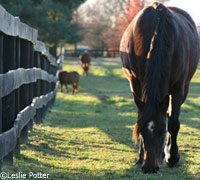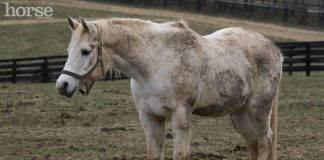 |
| Owners who board their horses can take steps to ensure their horses are protected from parasite infestation. Photo: Leslie Potter |
We’ve come a long way since the first half of the 20th century when parasites were a major killer of horses. Today, horse owners face a different concern: making sure their equine partners have an effective deworming program without overdoing it. There are only three basic chemical classes of deworming products on the market, and parasite resistance to these products is on the rise. Resistance can occur in parasite populations when horses are dewormed more often than necessary, even when owners rotate chemical classes.
“At the best-run boarding stables, things like vaccination and deworming are in the hands of a farm veterinarian, so at least these are controlled,” says Armon Blair, DVM, a veterinarian with Ocala Equine Hospital in Ocala, Fla.
Not all stables operate this way, however. One of the problems with boarding your horse is that you don’t have any control over how his pasturemates are dewormed.
In this situation, Blair recommends consulting with a veterinarian to develop the best plan for your own horse. “You can’t control re-contamination of your horse, so the best thing is to get your horse on a sensible program and stick to it,” he says.
That program will vary from one region of the country to the next, depending on the climate. This is why you need specific advice from a veterinarian familiar with parasite control in your area. There is no “blanket approach” that works for all horses or in all regions.
In the Southeast, for example, Blair advises following the protocol used at the University of Florida equine facility. In this program, manure samples are taken from each horse to run a fecal egg count (FEC) test in October. (Although not foolproof, such testing is currently the best way to determine parasite resistance, particularly in strongyles.)
Each horse is dewormed in October with an ivermectin product. In December, horses that had a high egg count in October (these horses are known as “high shedders”) are again tested and then treated with either Panacur or Strongid. In January, an FEC is again done on every horse and all horses are treated with ivermectin. The high shedders are treated again in April with a Panacur power pac.
“With this program, every horse is treated at least twice a year, and the high shedders are treated four times a year,” says Blair. “This is effective for parasite control and cost effective.”
If your boarding stable doesn’t have a general parasite control program, there are some steps you can take to help protect your horse, in addition to keeping him on a program advised by your veterinarian.
Don’t let your horse graze in heavily used public areas around the boarding stable or at a horse show. Always remove all old bedding and manure before putting your horse into a stall or corral that was used by other horses. If your horse is in a relatively small area, such as a corral or paddock, the best plan is to routinely remove all manure.
Horses kept in dirt lots or stalls have far less exposure to parasites simply because those conditions aren’t favorable for parasite survival. But virtually all horses turned out on pasture are exposed to infective strongyle larvae, which crawl out of manure and onto forage where grazing horses ingest them and the cycle starts again. Those horses found by testing to be high shedders are most responsible for contaminating the environment with infective parasite larvae. In an ideal boarding situation, these horses would not be pastured with low shedders, horses found by testing to have zero or low egg counts.
A lot of farms drag their pastures, using a harrow or metal drag to spread and break up manure piles. Unfortunately, this can actually help the parasites because it spreads the infective larvae over the grass where horses are eating.
Ideally, dragging should only be done during hot, dry weather when the sun can kill the larvae. Horses should be kept off the pasture for two to four weeks after dragging to avoid re-contamination. This isn’t practical for many farms, however, so your best bet is to control your horse’s environment as best you can, develop a consistent parasite plan with your vet and follow it closely.






This horse college is sooooo awesome! I love it! This is my last class! 🙁 Please make more classes Horse Channel! I LOVE these. I’ve learned soooo much more about horses and their diseases through this course.
Dear Horse Channel,
Can you play make more classes? Maybe more grooming ones and classes on buying a horse etc. ?
Thanks!
Great advice.
Good to know!